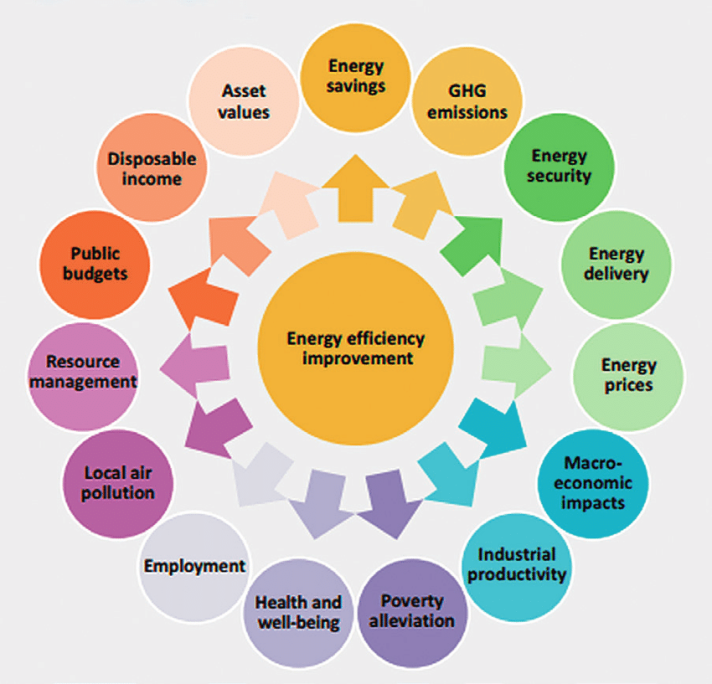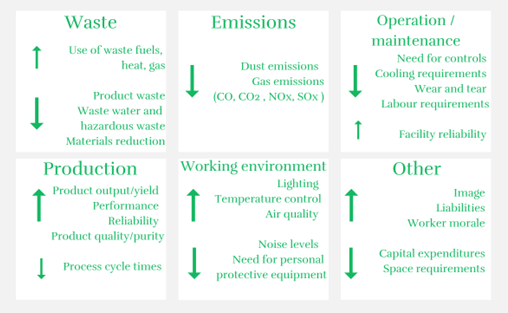
When looking at energy efficiency interventions, a simplified cost-benefit analysis only gives us limited information, not including all the externalities affecting society and the environment. The multiple or wider impacts of energy efficiency have been investigated for more than 30 years now. Yet, quantifying them as well as making them weighted and considered in impact assessments and ultimately in decision-making processes remains a challenge.
BEYOND THE SIMPLIFIED COST – BENEFIT ANALYSIS
The new Article 3 in the recast of the Energy Efficiency Directive promotes the use of cost-benefit methodologies that include the assessment of so-called “wider benefits”, to better reflect the societal perspective (to avoid short-sighted analysis).
Back in 2014, the International Energy Agency already listed these “wider benefits” such as health and wellbeing, employment and local air pollution. This analysis remains relevant although the list of such benefits grew longer. This is particularly true when looking into specific industry or business sectors with influences on maintenance, marketing and the whole value chain.
Analysis from the Horizon 2020-funded MICAT project shows that the monetised value of the impacts, based on different research, goes up to being three times higher than the value of savings alone. Highest values come from the impacts on health (either through air pollution reduction or through alleviation of energy poverty). These figures are clearly significant: not taking them into account can lead to wrong decisions. And it’s not only the numbers, but also the way energy is powering society.
PRIORITISING ENERGY EFFICIENCY GENERATES ADDITIONAL BENEFITS
The Energy Efficiency First principle, defined in the 2018 Governance Regulation of the Energy Union (EU) , aims to consider and prioritise investments in demand side resources (energy efficiency interventions, for example, building retrofits) whenever more cost-effective than supply side resources (investments in energy infrastructure or production), considering a broad enough scope of impacts, and a long enough perspective.
In simple terms, it means to choose to use less before creating more. To be able to level energy efficiency with the resources and compare them fairly, the calculations should include socio-economic-environmental effects in the form of various multiple impacts. The results from H2020 ENEFIRST project show that, amongst others, the inclusion of the estimated cost of air pollution and climate change consequences has a strong impact on the cost-effectiveness of energy efficiency measures from a societal viewpoint.
Without taking into account the wider benefits of energy efficiency, there was no obvious distinctions between 3 scenarios and levels of ambition for building renovation when considering the whole energy system costs. But once adding wider impacts in the assessment, the case for the highest ambition became clear.
IT IS IMPORTANT FOR THE SOCIETY, BUT WHAT ABOUT THE COMPANIES?
Companies, and mainly SMEs, do not have enough workforce, technical or financial capacity to focus on energy audits or energy efficiency, as shown for example in the Horizon 2020 project DEESME. Looking at things from a companies’ management perspective, it is hard to see the strategic value of energy efficiency for the company versus society, if there is no clear financial benefit.
Therefore, raising their awareness and giving them tools and funding to consider the multiple impacts when taking investment decisions would motivate them to see the business side of energy efficiency.
The M-Benefit project developed a methodology to ensure that the process of the energy audit fits with the strategic view of the companies. Providing numbers helps. Providing the right number to the right person in the right phrasing is even more effective. Considering wider benefits is not only about changing the assessment methods: it is about changing the way of thinking energy efficiency. From a technical topic to identifying what matters the most to decision-makers.
BY SOCIETY, DO WE MEAN THE WHOLE SOCIETY?
When including the multiple benefits of energy efficiency investments, the calculations sometimes look at the citizens, companies, or society as a whole, a task that might overlook the most vulnerable and marginalised parts of society. IEECP analysed for the European Climate Foundation how the same policies, beneficial for all, might influence low-income households.
If well-designed, the EU Renovation Wave, for example, can cut low-income households’ energy costs by a third, derive all the benefits and increase the disposable income. So, the conclusion is yes, on the long-term, energy efficiency stands out as the best solution, especially if we take into account the wider societal perspective and the needs of the most vulnerable.
Recommended links:
- A Cost-Benefit Analysis and aggregation methodology from MICAT
- Energy Efficiency First and Multiple Impacts: integrating two concepts for decision-making in the EU energy system from ENEFIRST
- More about the multiple benefits for companies in the DEESME project
About the author:
Ivana is Senior Energy expert at IEECP.
Before joining IEECP in 2020, Ivana was working since 2013 in the Society for Sustainable Development Design as a Project Manager/Senior Expert and Program Director, managed and worked on more than 15 projects in the field of energy and climate. She (co)-authored policy analysis and recommendations in the area of energy efficiency and renewable energy, SECAPs, publications, research and educational materials. Ivana worked from 2007 to 2013 for the energy service company HEP ESCO, where she participated in the implementation of first energy efficiency projects in Croatia.
She is a Member of the Steering Committee of the Covenant of Companies, EEFIG working group, Advisory Boards of projects, local energy transition advisory group, Management Board of DOOR and is an external lecturer on ETS in the Energy Economics MBA.
In IEECP, Ivana is leading the work in energy efficiency in business sector.
She obtained a CMVP certificate, professional education for energy audits in buildings, one year education on management of EU funding. Her educational background includes a MSc in Electrical Engineering – Energy Systems (Faculty of Electrical Engineering and Computing, Zagreb, Croatia), a MSc (specialist degree) in Environmental Engineering (University of Zagreb, Center for Postgraduate studies) and an MBA in Energy Economics (Faculty of Economics and Business, Rijeka, Croatia). She is currently a PhD student in Economics.
Disclaimer: This article is a contribution from a partner. All rights reserved.
Neither the European Commission nor any person acting on behalf of the Commission is responsible for the use that might be made of the information in the article. The opinions expressed are those of the author(s) only and should not be considered as representative of the European Commission’s official position.
RELATED ARTICLES:
➔ Out with the old, in with the bold: the road to autonomy is through sustainability
➔ Europe's net zero industry future: it’s electrifying!
➔ Revised Energy Efficiency Directive: New rules, more savings, higher benefits.
Details
- Publication date
- 15 June 2023
- Author
- European Climate, Infrastructure and Environment Executive Agency


